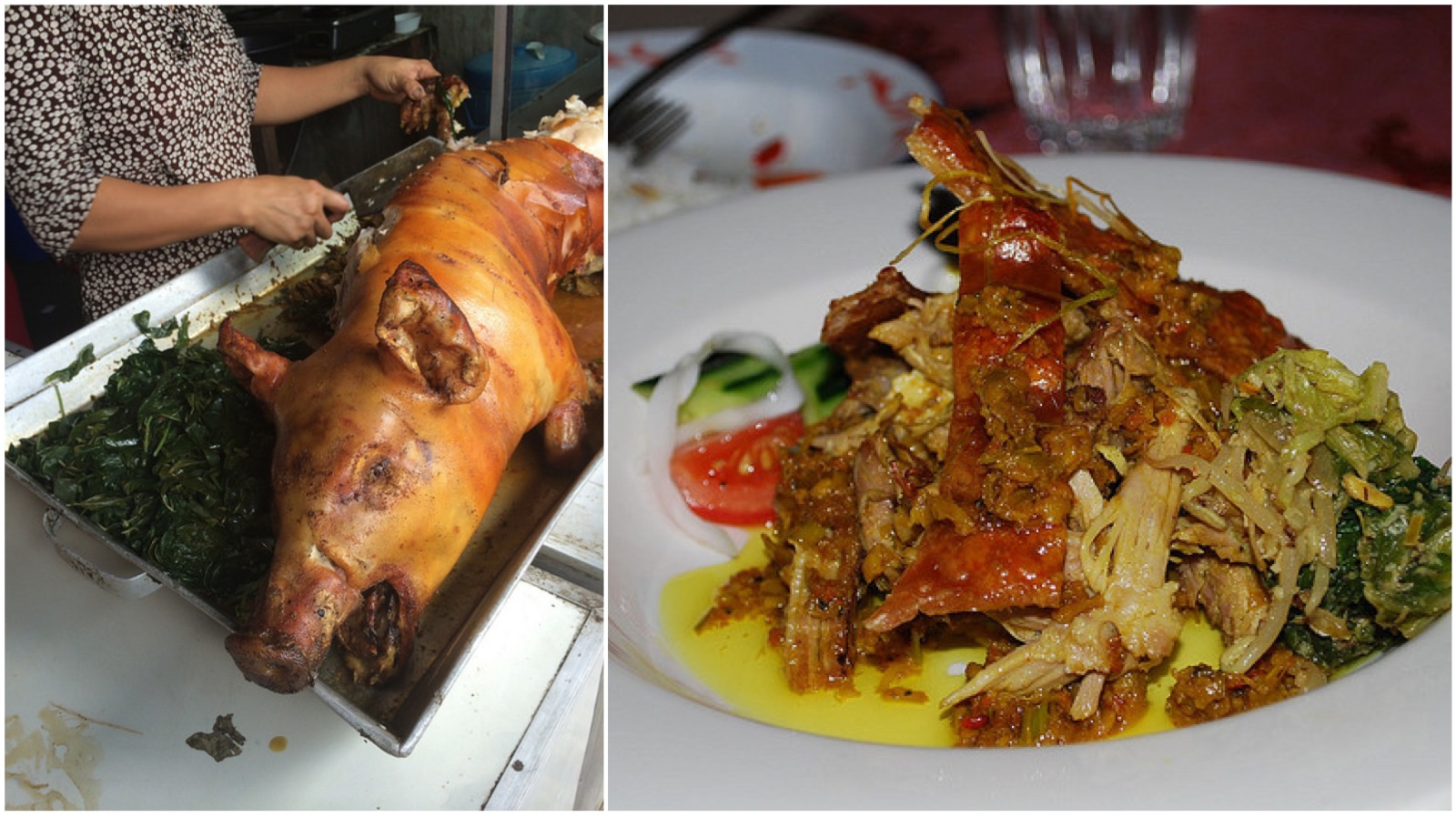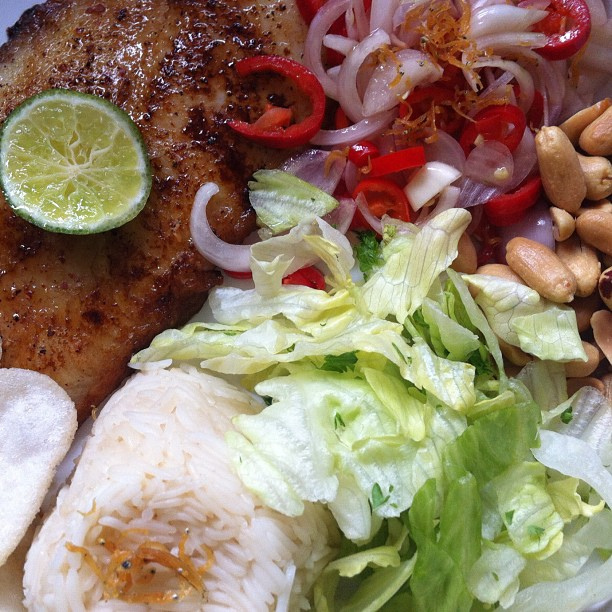Like much of Indonesia, eating street-food (or warung food) in Bali is an adventure in itself.
While tucking into Indonesian favorites (i.e. bakso, martabak, gado-gado) will delight any street-food connoiseurs, we think that when in Bali, you should take the time to sample a few dishes that are actually from Bali.
After all, Indonesia’s diversity doesn’t just apply to traditional costumes, religion, and urban myths. It also applies to our food (some people will even say that it’s our greatest source of pride).
Every region in Bali has its own speciality dish that can be found across warungs or sold in street stalls. Our favorites (which hail from all over the island) are as follows:
1. Sate lilit
We Indonesians love our meat on skewers, so much that almost every region in Indonesia has its own sate.
Bali is not different. In fact Bali has many sate variations. Choosing a favorite was tough, but we settled on good old sate lilit, a minced meat, grated coconut, coconut milk, lemon juice, shallots and chilli pepper combo wound around a bamboo, sugar cane or lemongrass stick, all grilled on charcoal. It can be a spicy one, but oh so delish.
Authentic Balinese sate lilits are generally made out of pork and fish but you can find chicken or beef ones on the island from time to time.

Photo: Flickr
2. Babi guling
The suckling pig is definitely a dish unique to Bali, with Indonesia’s majority being Muslim and therefore non-pig eaters. You probably won’t find much pig-meat based dishes in most parts of the country.
In Hindu Bali, however, babi guling is the local dish. In Balinese traditions, babi guling is normally served as an offering during religious ceremonies (like this one here) but its popularity amongst pig-loving tourists who literally drool over this dish has lead to its widespread availability throughout the island.
Babi guling is roasted whole over fire, stuffed with onions, garlic, ginger, galangal, turmeric, lemongrass, shallots, chillies and whatever other goodness the babi guling warung chef decides would render his or her dish delicious.

Photos: Flickr
3. Lawar
Usually served with steamed rice and babi guling, lawar is a mix of vegetables, coconut and minced meat drowned in rich herbs and spices (including shrimp paste, ground pepper, green beans and jackfruit), sometimes added with blood to intensify the taste. It’s a very common dish that you will find across most warungs in Bali.
You’ll find all sorts of lawar in Bali. Pork lawar and jackfruit lawar are pretty common, or if you are into trying exotic things, dragonfly lawar can also be found. These aren’t as readily available though, as they take a long time to prepare due to the amount of dragonflies needed to make it (which probably also means lengthy capturing time).

Photo: Wikimedia Commons
4. Nasi campur
If there is one thing that Indonesians can’t live without, it’s nasi.
So technically nasi campur is not from Bali, because much like sate, every region in Indonesia claims to have its own version, including Bali.
We do love the Bali version though, and it’s an easy thing to order when we can’t make a decision because you get multiple goodness of Balinese food inside a banana leaf. And then there’s the surprise factor—you don’t know exactly what you’re going to get (unless you’re doing a serve yourself sort of deal). It could be grilled tuna, tofu, fried tempeh, spinach, sate lilit, who knows?
We did find one thing in common across most Balinese nasi campurs. When you order it from local eateries, the sambal they put on the side (or on top) tends to be ridicolously spicy. Beware and enjoy.

Photo: Flickr
5. Nasi jinggo (also referred to as nasi jenggo)
You know how sometimes you get hungry at 10pm and you want to eat something filling, but not exactly eat a whole meal?
Nasi jinggo (or jenggo) is designed for those night cravings. It’s kind of a smaller version of nasi campur, but generally contains white rice, crispy fried tempeh with chillies, shredded chicken and serundeng (shredded coconut fried with a myriad of spices). Only available in Bali.

6. Sambal matah
What are the special ingredients anyway? Shallots, lemongrass, shrimp paste, garlic, lime zest, and a looooot of bird’s eye chillies. All raw and fresh.

Photo: Flickr
7. Bubur mengguh
A Buleleng speciality, this is a more coconut-y version of bubur ayam (chicken rice porridge commonly eaten for breakfast all over Indonesia).
The rice porridge, which is sometimes cooked in coconut milk, is served with an assortment of fried peanuts, green beans, and chicken cooked with bay leaves and galangal. There is also usually an additional sauce, composed of red and brown onions, shallots, turmeric, red-chillies, hazelnut, coriander, salt and ground pepper. Sometimes coconut oil is added for extra richness.

8. Srombotan
This vegetable dish hails from Klungkung and therefore commonly found across the three Nusa islands, though also available on Bali’s mainland.
Serombotan is a mix of veggies drizzled with sambal kelapa (coconut chilli sauce) and bumbu koples, which is kind of like a sweet soy sauce mixed with a myriad of spices. Yes, we know, there is an overwhelming amount of coconuts involved in these dishes, but on an island where a lot of it is grown locally, why wouldn’t you use it?
Sambal kelapa is usually made out of shredded coconuts, crushed chillies, onions, lime juice, galangal, shrimp paste, and salt. It is blended (or crushed) together and fried to perfection. Bumbu koples is made out of peanuts, palm sugar, shrimp paste, chillies, lime juice and sweet soy sauce. Like most Balinese sauces, coconut oil is sometimes added to up the flavoursomeness.
9. Jaja Bali
For those with a sweet tooth, you cannot leave Bali without trying Jaja Bali, which is an assortment of kue (sweet treats) that hail from the island.
Depending on which market stalls or warung you purchase it from, some of the kue you can expect include laklak (rice-flour muffins with grated coconut and drizzled with palm sugar caramel), pisang rai (steamed banana with grated coconut), bubur injin (black rice pudding with coconut milk sauce) and dadar (pandan crepes filled with palm sugar and coconut).

Dadar
Photo: Flickr





Reader Interactions